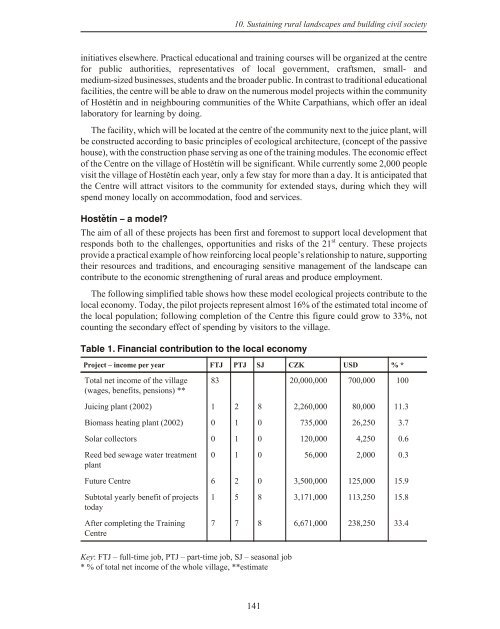The Protected Landscape Approach - Centre for Mediterranean ...
The Protected Landscape Approach - Centre for Mediterranean ...
The Protected Landscape Approach - Centre for Mediterranean ...
Create successful ePaper yourself
Turn your PDF publications into a flip-book with our unique Google optimized e-Paper software.
10. Sustaining rural landscapes and building civil society<br />
initiatives elsewhere. Practical educational and training courses will be organized at the centre<br />
<strong>for</strong> public authorities, representatives of local government, craftsmen, small- and<br />
medium-sized businesses, students and the broader public. In contrast to traditional educational<br />
facilities, the centre will be able to draw on the numerous model projects within the community<br />
of Hosttín and in neighbouring communities of the White Carpathians, which offer an ideal<br />
laboratory <strong>for</strong> learning by doing.<br />
<strong>The</strong> facility, which will be located at the centre of the community next to the juice plant, will<br />
be constructed according to basic principles of ecological architecture, (concept of the passive<br />
house), with the construction phase serving as one of the training modules. <strong>The</strong> economic effect<br />
of the <strong>Centre</strong> on the village of Hosttn will be significant. While currently some 2,000 people<br />
visit the village of Hosttn each year, only a few stay <strong>for</strong> more than a day. It is anticipated that<br />
the <strong>Centre</strong> will attract visitors to the community <strong>for</strong> extended stays, during which they will<br />
spend money locally on accommodation, food and services.<br />
ˆ<br />
Hostetín – a model<br />
<strong>The</strong> aim of all of these projects has been first and <strong>for</strong>emost to support local development that<br />
responds both to the challenges, opportunities and risks of the 21 st century. <strong>The</strong>se projects<br />
provide a practical example of how rein<strong>for</strong>cing local people’s relationship to nature, supporting<br />
their resources and traditions, and encouraging sensitive management of the landscape can<br />
contribute to the economic strengthening of rural areas and produce employment.<br />
<strong>The</strong> following simplified table shows how these model ecological projects contribute to the<br />
local economy. Today, the pilot projects represent almost 16% of the estimated total income of<br />
the local population; following completion of the <strong>Centre</strong> this figure could grow to 33%, not<br />
counting the secondary effect of spending by visitors to the village.<br />
Table 1. Financial contribution to the local economy<br />
Project – income per year FTJ PTJ SJ CZK USD % *<br />
Total net income of the village<br />
(wages, benefits, pensions) **<br />
83 20,000,000 700,000 100<br />
Juicing plant (2002) 1 2 8 2,260,000 80,000 11.3<br />
Biomass heating plant (2002) 0 1 0 735,000 26,250 3.7<br />
Solar collectors 0 1 0 120,000 4,250 0.6<br />
Reed bed sewage water treatment<br />
plant<br />
0 1 0 56,000 2,000 0.3<br />
Future <strong>Centre</strong> 6 2 0 3,500,000 125,000 15.9<br />
Subtotal yearly benefit of projects<br />
today<br />
After completing the Training<br />
<strong>Centre</strong><br />
1 5 8 3,171,000 113,250 15.8<br />
7 7 8 6,671,000 238,250 33.4<br />
Key: FTJ – full-time job, PTJ – part-time job, SJ – seasonal job<br />
* % of total net income of the whole village, **estimate<br />
141

















